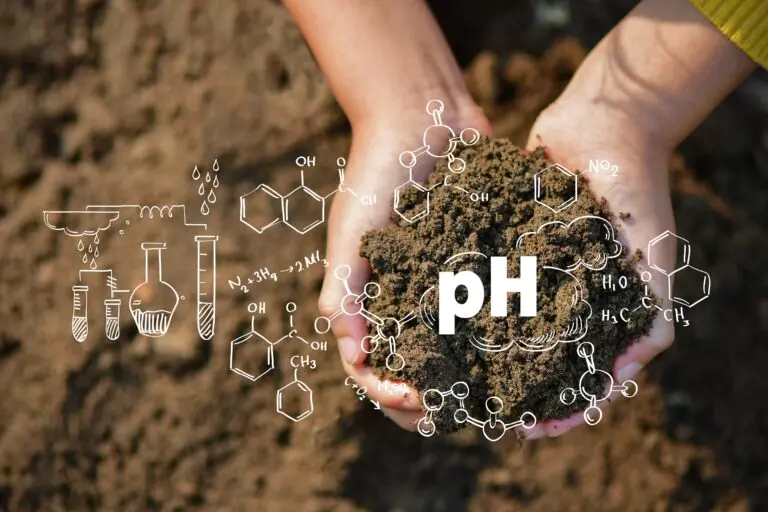
WHAT IS SOIL pH?
Soil pH, or soil reaction, allows determining whether the soil is acidic or alkaline. Each plant has different nutritional requirements, including those related to soil pH. Soil pH affects the availability of nutrients for plants. In acidic soil, fewer organisms supporting plant growth, such as fungi, bacteria, or earthworms, thrive.
Soil pH is nothing more than the ratio of hydrogen ions H+ to hydroxyl ions OH- in the soil. It is expressed on the pH scale. Soils are distinguished as follows:
Strongly acidic – pH < 4.5
Acidic – pH from 4.5 to 5.5
Slightly acidic – pH from 5.6 to 6.5
Neutral – pH from 6.6 to 7.2
Alkaline – pH > 7.2
HOW TO CHECK SOIL pH?
Plants should have proper fertilization and soil pH. You can check it yourself or commission a laboratory test. It’s best to take three or four soil samples from an area of 100 m² from a depth of about 10–20 cm. These prepared samples should be subjected to analysis, which can be carried out:
- Independently at home
- Using litmus paper
- With a pH meter
- Using a probe
- With the AgroCares soil scanner
- In a laboratory.
SELF-MEASUREMENT OF SOIL pH AT HOME
This is the least accurate method of determining soil pH. It only allows determining whether the soil is acidic or alkaline. It’s not possible to precisely determine the pH value. The measurement is done by placing soil samples in two jars and adding distilled water to each. Then shake them to obtain a relatively uniform mud. Next, add some baking soda to one jar and a small amount of vinegar to the other. If a reaction occurs in the jar with baking soda (it foams), it indicates acidic soil. If bubbles appear in the jar with vinegar, it indicates alkaline soil. If there’s no reaction in either jar, the soil has a neutral pH.
MEASURING SOIL pH WITH LITMUS PAPER
Soil pH can also be measured independently using litmus paper (available in sets at online stores, gardening stores, and pharmacies). To measure, put a soil sample in a jar and add distilled water, then shake the jar to obtain a relatively uniform consistency. Dip the litmus paper into the muddy solution. After half an hour, the color of the litmus paper changes. Compare it with the scale colors on the packaging to determine the soil’s pH.
MEASURING SOIL pH WITH A pH METER
Soil pH can also be measured using a pH meter, which can be purchased at gardening stores. This is an inexpensive, reusable set (30-40 PLN) that includes a plastic plate and Hellig’s liquid. Soil measurement should be performed according to the attached instructions. A pinch of soil is placed in the designated area, then several drops of Hellig’s liquid are added. After a few minutes, the liquid changes color. Soil pH is read by comparing the obtained color of the solution with the color scale provided by the manufacturer.

MEASURING SOIL pH WITH A METER
When measuring soil pH amateurishly, various types of meters can be used. The simplest ones are mechanical devices with a pointer. They are inserted into the soil, and after a while, the scale can be read to determine the soil’s pH. This type of meter indicates soil pH. However, the accuracy of the measurement remains debatable.
Electronic meters powered by batteries can also be used. Measurement with these meters is much more precise. Just insert it into the soil, and the screen displays the soil’s pH. Additionally, you can read the temperature and humidity of the tested soil and its insolation. Even when using electronic meters, pH measurement is subject to error, the magnitude of which depends on the device’s class. The higher the purchase price of the meter, the greater the measurement accuracy.
MEASURING SOIL pH WITH THE AGROCARES SOIL SCANNER
The newest method for quickly measuring the most important soil parameters, including soil pH, is spectrometry technology. One of the most accurate devices for field measurement of soil parameters in this technology is the AgroCares soil scanner. This device emits near-infrared light, which penetrates the soil sample. Then the soil scanner records the reflected light. The spectrum is sent to a database where it is converted into data regarding the analyzed soil parameters. The results obtained are delivered to the computer in the form of a report. Soil sample analysis in real-time is non-invasive and takes about 10 minutes. The AgroCares soil scanner provides the following data on mineral element contents and selected properties of the analyzed soil sample: pHH2O, organic matter, available phosphorus (M3), total nitrogen, exchangeable potassium, exchangeable calcium, exchangeable magnesium, potentially mineralizable nitrogen, total clay, total iron, clay fraction, and humidity.
This device is part of the equipment of agronomists from Polcalc Nawozy Wapniowe Sp. z o. o. They provide a free soil analysis service using the AgroCares soil scanner for farmers collaborating with official distributors of granulated fertilizers produced by Polcalc Nawozy Wapniowe Sp. z o.o. Special mention should be made of fertilizers contributing to soil acidification and improving its properties, such as Polcalc Third Generation and SuperMag. We encourage interested individuals to contact official distributors throughout Poland or our company: www.polcalc.pl.
SOIL pH MEASUREMENT IN THE LABORATORY
The most accurate measurement of the parameters of the analyzed soil can be obtained when soil samples are analyzed in the laboratory. This method is particularly recommended for farmers who need to have all soil parameters under control and cannot afford inaccuracies and mistakes in measurement. Depending on the field area from which the measurement needs to be taken, one average sample is taken from a maximum of 3-4 ha. It is obtained by mixing 20-25 individual samples collected from the field following the procedures provided by the Agricultural Soil Science Society (OSChR) on their websites. Then they should be sent for laboratory analysis. This will provide reliable information about the soil’s pH and other analyzed indicators.
Soil pH testing should ideally be done once a year after harvesting crops grown in a particular field. The best time is between August and November, before planting crops in the field. This is necessary because soil parameters change over time and under the influence of various factors.
HOW TO CHANGE SOIL pH?
What should be done if it turns out that the soil pH is not as it should be? How to change it?
If it turns out that the soil has a too high pH, it should be acidified. This can be done by mixing the soil with acidifying fertilizers such as ammonium phosphate, ammonium nitrate, urea, acidic peat, or bird manure. If the test shows that the soil has a too low pH, it will be necessary to lime it. To do this, mix the soil with powdered lime, for example, Kujawit, Kujawit Premium, or in the case of acidic soil with low magnesium content, Radkowit, Radkowit Premium. Broadcasting granular lime, such as Polcalc Third Generation or SuperMag (for acidic soils with low magnesium content), is also a very good solution. Detailed information about the mentioned fertilizers can be found on our website www.polcalc.pl. We also encourage you to contact our official distributors.






